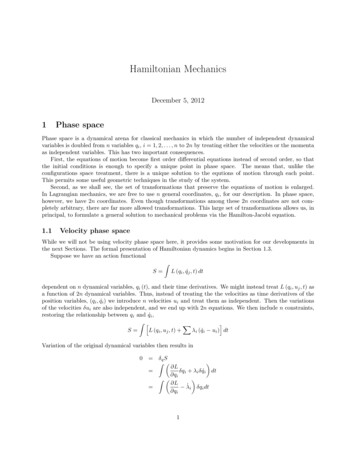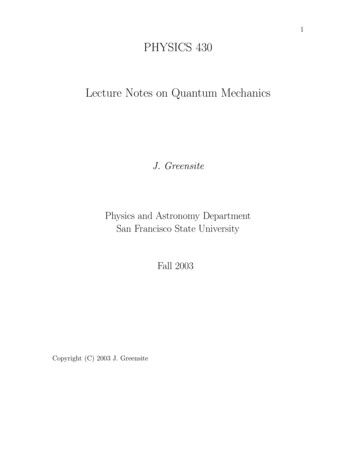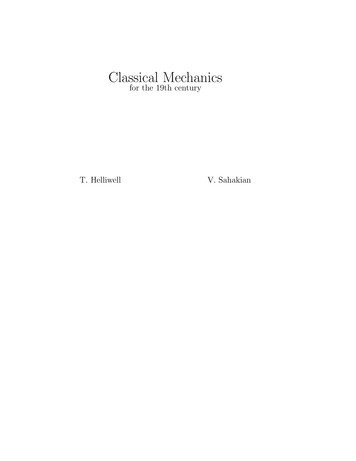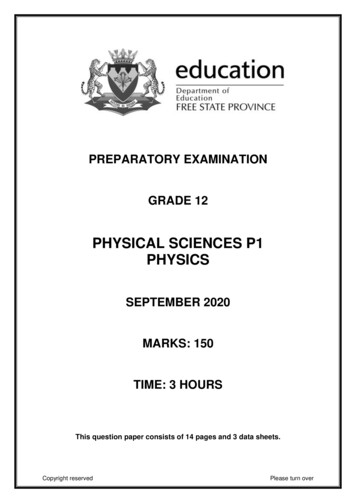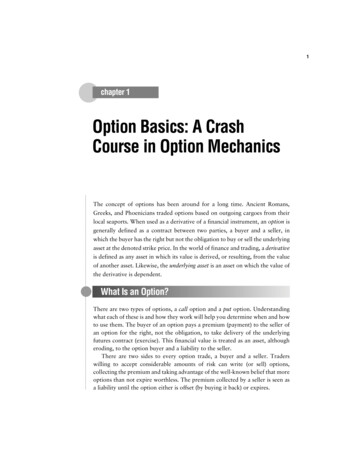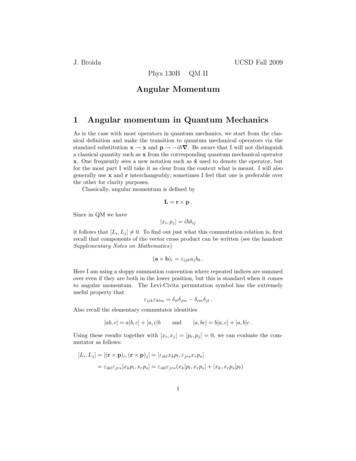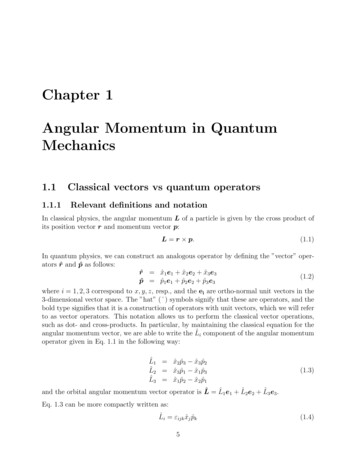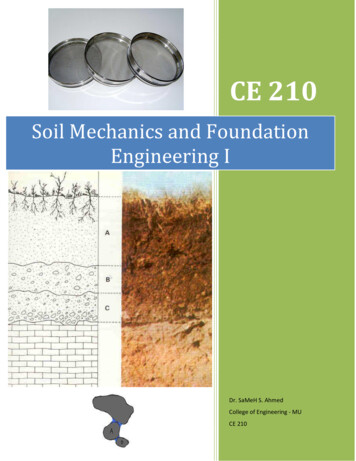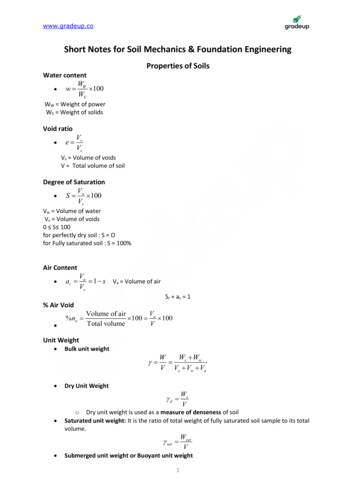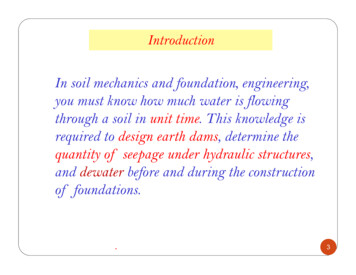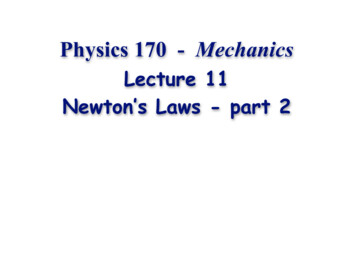
Transcription
Physics 170 - MechanicsLecture 11Newton’s Laws - part 2
Newton’s Second Law of MotionAn object may have several forces acting on it;the acceleration is due to the net force:
Newton’s Second Law of MotionNewton’s 2nd Law:An object of a given massm subjected to forces F1,F2, F3, will undergo anacceleration a given by:a Fnet /mwhereFnet F1 F2 F3 The mass m is positive,force and acceleration arein the same direction.
Newton’s Third Law of MotionThe harder one sumowrestler pushes, theharderthe other pushes back.Newton’s third lawdescribeshow two objects interactwith each other.
Newton’s Third Law of MotionForces always come in pairs, acting on differentobjects:If Object A exerts a force F on Object B, thenObject B exerts a force –F on Object A.These forces are called action-reaction pairs.Alternate Wording: “For every action there is an equal and opposite reaction.”
Example: Pulling a Rope (1)1A student pulls horizontallywith a force of 100 N on a ropethat is attached to a wall.2Two students pulls on oppositeends of a rope with forces of100 N each.Which tension is larger?a. T1 T2b. T1 T2c. T1 T2
Examples of Force VectorsPull(contact force)Push(contact force)Gravity(long-range force)
A Catalog of Forces:(1. Normal)Normal ForceA solid object resists the action of another force which compresses itwith what we call the normal force. The normal force always acts outwardand perpendicular to the surface of the compressed object. The symbolfor the normal force is n.
A Catalog of Forces: (2. Weight)WeightThe falling box is pulled toward the Earthby the long-range force of gravity. Thegravitational pull on a object on or near thesurface of the Earth is called weight, for whichwe use the symbol w.Weight is the only long range force that wewill consider in this course. The agent for theweight force is the entire Earth pulling on theobject. Weight acts equally on objects at restor in motion. The weight vector always pointsvertically downward, and it can be consideredto act at the center of mass of the object.
A Catalog of Forces: (3. Spring)Spring ForceA stretched or compressed spring exerts one of the most common contactforces. A spring can either push (when compressed) or pull (when stretched).In either case, the tail of the vector force is attached to the contact point.There is no special symbol for the spring force, but we can use Fsp.
A Catalog of Forces: (4. Tension)Tension ForceA string or rope exerts a contactforce on an object when it pulls onit. We call this a tension force,represented by the symbol T.Tension is always directed along theline of the rope or string, with nocomponent perpendicular to it.Microscopic ViewA powerful microscope would seethat the string was made up ofatoms connected by molecular bonds,that can be thought of as tinysprings holding the atoms together.
A Catalog of Forces: (5. Friction)FrictionAt the molecular level, surfaces tend to stick together, impeding motion.This produces the force we call friction. It comes in two varieties:Kinetic friction, denoted by the symbol fk , appears when an object slidesacross a surface. This is a force that opposes the motion and points in theopposite direction from the velocity.Static friction denoted by the symbol fs , is a force that keeps an objectat rest stuck to a surface and prevents its motion. It points in the directionthat prevents motion. Typically, it is larger than the kinetic friction thatappears after the object begins to move.
Identifying Forces Identify “the system” and “the environment.” The system is theobject whose motion you wish to study; the environment is everythingelse. Draw a picture of the situation. Show the object—the system—andeverything in the environment that touches the system. Ropes, springs,and surfaces are all parts of the environment. Consider a system at the time. Locate every point where the environment exerts contact forceson the object. Name and label each contact force acting on the object. There isat least one force at each point of contact; there may be more than one.When necessary, use subscripts to distinguish forces of the same type. Name and label each long-range force acting on the object. Fornow, the only long-range force is weight.
Normal ForceThe normalforce is theforce exertedby a surface onan object.
Normal ForceThe normal force is always perpendicular tothe surface that produces it.
Normal ForceThe normal force may be equal to, greaterthan, or less than the weight.
Apparent WeightYour perception of your weight is based onthe contact forces between your body and yoursurroundings.If your surroundingsare accelerating,your apparent weightmay be more or lessthan your actualweight.
Example:Weighing Yourself in anElevatorSuppose that your mass is 80 kg, and you are standingon a scale fastened to the floor of an elevator. Thescale measures force and is calibrated in newtons.(a) What does the scale read when the elevator isrising with acceleration a?(b) When it is descending with acceleration a’?the a push up so the apparent weight is morethe a push down so the apparent weight is less
Using Free-Body Diagrams
Example: A sledDuring your winter break, you pull a rope attached tothe sled with a force of 150 N at 25 above thehorizontal. The mass of the sled-rope system is 80 kg,and there is negligible friction between the sled runnersand the ice.(a) Find the acceleration of the sled(b) Find the magnitude of the normal force exerted onthe surface by the sled.X:y:
Example: Unloading A TruckYou are working for a big delivery company, andyou must unload a large, fragile package from yourtruck, using a 1 m high frictionless delivery ramp.If the downward component of velocity of thepackage is greater than 2.50 m/s when it reachesthe bottom of the ramp, the package will break.What is the greatest angle θ at which you cansafely unload?Δx
StringsWhen you pull on a string or rope, it becomes taut.We say that there is tension in the string.
Connected ObjectsWhen forces are exerted on connected objects, theiraccelerations are the same.If there are two objects connected by a string, and we knowthe force and the masses, we can find the acceleration and thetension:
Connected ObjectsWe treat each box as a separate system. Wewrite separate equations for each and solve themtogether.
The Massless StringApproximationA horizontal force F acts on a block that is connected to anotherblock by a string. Consider the constraints and the forces.Massless String Approximation:TA on S TB on S
Example: Comparing TensionsBlocks A and B are connected by massless String 2 and pulled across africtionless surface by massless String 1. The mass of B is larger than themass of A.Is the tension in String 2 smaller, equal, or larger than the tension inString 1?
.
Translational EquilibriumWhen an object is in translational equilibrium,the net force on it is zero:An object in translational equilibrium is either at rest ormoving with a constant velocity.Its acceleration is zero.
Example: Picture HangingA picture weighing 8.0 N is supported by two wireswith tensions T2 and T2.Find each tension.X:y:
Example: Mountain Climbing (1)A 90 kg mountainclimber is suspendedfrom ropes as shown.Rope 3 can sustain amaximum tension of1500 N before breaking.What is the smallestthat angle θ can becomebefore the rope breaks?
Example: Mountain Climbing (2)
Example:An Accelerating Jet PlaneAs your jet plane speeds along the runway on takeoff, youdecide to determine its acceleration, so you take out youryo-yo and note that when you suspend it, the string makesan angle of 22 with the vertical.(a) What is the acceleration of the airplane?(b) If the mass of the yo-yo is 40.0 g, what is the tension inthe string?y:X:
by the long-range force of gravity. The gravitational pull on a object on or near the surface of the Earth is called weight, for which we use the symbol w. Weight is the only long range force that we will consider in this course. The agent for the weight force is the entire Earth pull

